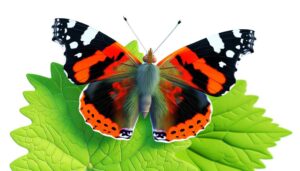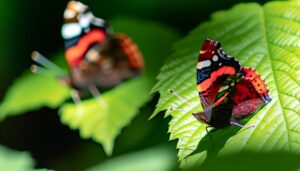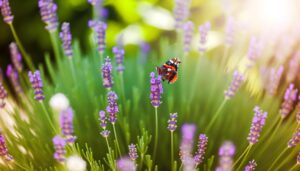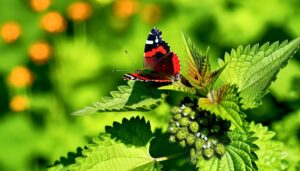Safely Observing Red Admiral Butterflies: Are They Poisonous?
Red Admiral butterflies (*Vanessa atalanta*) are not poisonous to humans. Unlike certain butterflies that sequester toxins from their larval host plants, Red Admirals lack such harmful compounds.
Their primary defense mechanisms include cryptic coloration and erratic flight patterns to evade predators rather than relying on toxicity. Empirical evidence confirms that handling or contact with Red Admirals does not result in adverse effects for humans.
Consequently, they are deemed harmless and safe to interact with. To gain a thorough understanding of their defense strategies and ecological roles, further exploration into their behavior and diet is beneficial.
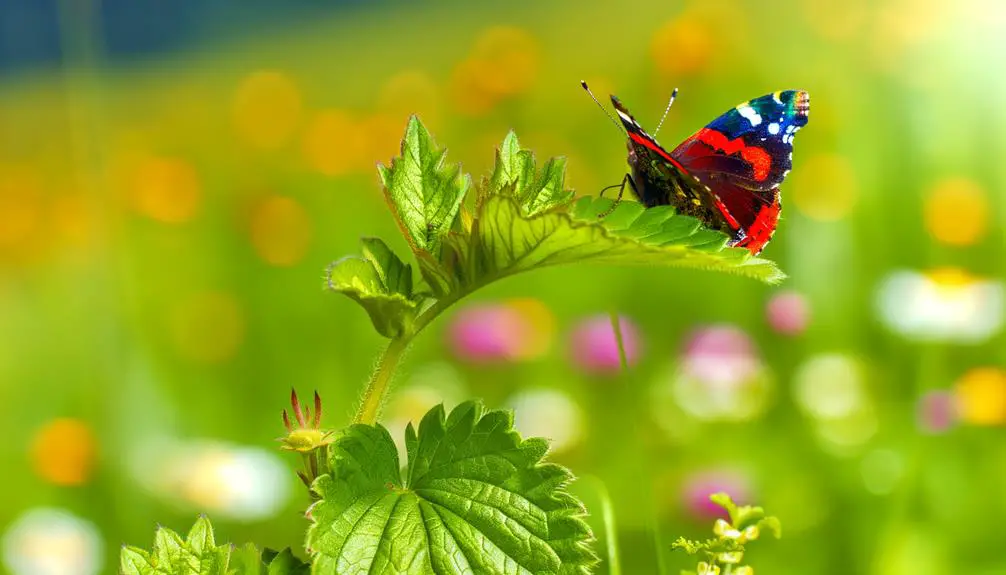
Key Takeaways
- Red Admiral butterflies are harmless to humans and pose no significant threat.
- They lack toxic compounds found in some other butterfly species.
- Bright coloration is for predator deterrence, not an indication of toxicity.
- Handling Red Admirals typically causes no skin irritation or adverse effects.
Identifying Red Admiral Butterflies
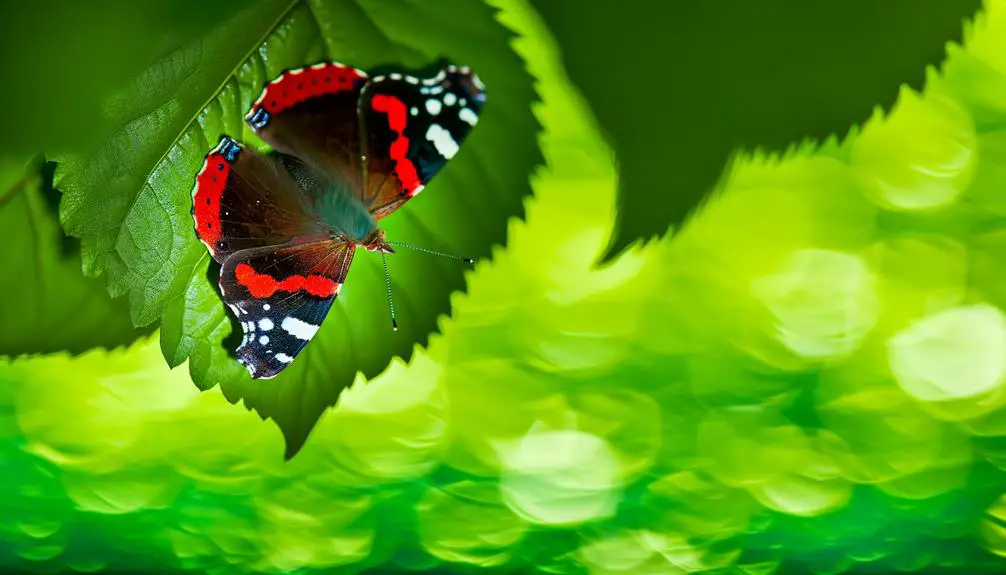
The Red Admiral butterfly (Vanessa atalanta) can be identified by its distinctive black wings adorned with striking red bands and white spots. The forewings exhibit an orange-red median band and white apical spots, while the hindwings feature a red marginal band. The wingspan ranges from 45 to 50 millimeters.
Significantly, the ventral side of the forewings is mottled with brown, black, and white, providing effective camouflage. Antennae are clubbed, aiding in orientation and balance during flight.
Sexual dimorphism is minimal, making males and females visually similar. The larvae, or caterpillars, also exhibit unique characteristics, including a spiny exterior and variable coloration, typically green or brown, which aids in their identification.
Understanding these features is essential for accurate identification.
Habitat and Distribution
Red Admiral butterflies primarily inhabit temperate regions, thriving in diverse environments such as woodlands, gardens, and coastal areas. These habitats provide essential resources such as nectar from flowering plants and host plants for larvae.
The species is widely distributed across North America, Europe, Asia, and North Africa, exhibiting remarkable adaptability to various climatic conditions. Detailed observations reveal their preference for sunny locations, often seen basking in the sun to regulate their body temperature.
- Woodlands: A haven of dappled sunlight and abundant nectar sources.
- Gardens: Urban sanctuaries providing essential floral resources.
- Coastal Areas: Unique microclimates supporting diverse flora.
- Meadows: Open spaces with a profusion of wildflowers.
Their widespread presence underscores their ecological significance and adaptability.
Red Admiral Diet
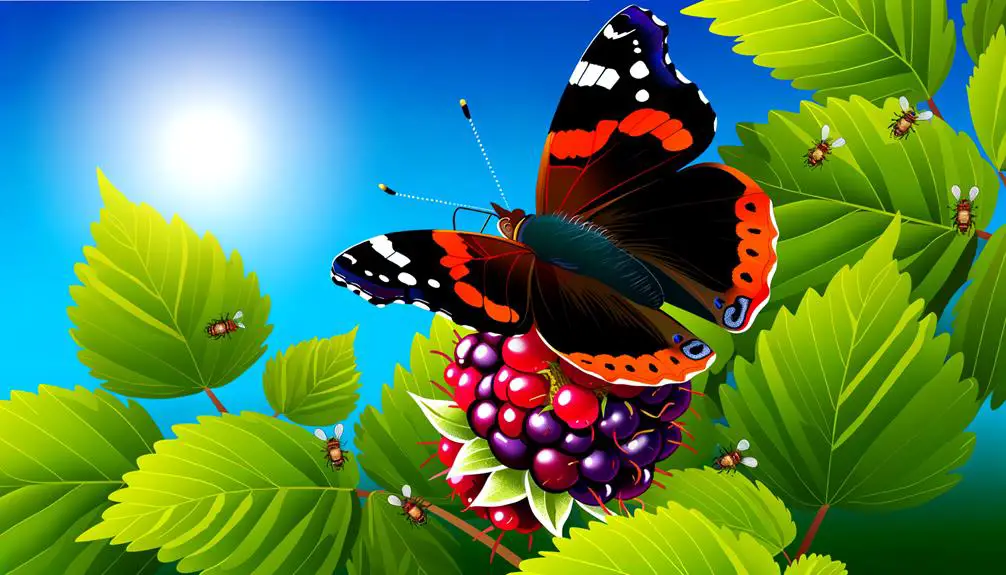
The Red Admiral butterfly (Vanessa atalanta) exhibits a varied diet that includes a preference for nectar from flowering plants and tree sap, which provides essential nutrients for its survival.
Observations indicate that its larvae mainly feed on nettles (Urtica spp.), showcasing a specific host plant relationship critical for its reproductive cycle.
Additionally, seasonal feeding habits are evident, with adults often consuming overripe fruit and other sugary substances during autumn to accumulate energy reserves for migration and overwintering.
Nectar and Sap Preferences
Red admiral butterflies primarily consume nectar from a variety of flowering plants, demonstrating a preference for those with rich, readily accessible nectar sources. Their feeding behavior highlights key ecological interactions, contributing to both pollination and plant health. In addition to nectar, red admiral butterflies eating fruit is a common sight, particularly when they feed on overripe or fermenting fruit. This dietary flexibility allows them to thrive in diverse environments while also playing a role in nutrient recycling. Their ability to consume both floral nectar and fruit juices supports their survival across different seasons and habitats.
Detailed observations reveal that these butterflies exhibit a marked preference for certain nectar sources, often gravitating towards flowers with high concentrations of sugar. In addition to nectar, red admirals also feed on tree sap, fermenting fruits, and even dung, reflecting their opportunistic and adaptive foraging strategies.
- Vibrant blooms of Buddleia and Echinacea
- Juicy, fermenting fallen fruits
- Oozing sap from wounded trees
- Pungent, nutrient-rich dung
This diverse diet underscores the red admiral’s role in various ecosystems.
Host Plant Choices
Utilizing a diverse array of host plants, Vanessa atalanta larvae primarily feed on nettles, particularly Urtica dioica, demonstrating an essential relationship between butterfly survival and specific vegetation.
Research indicates that the nutritional composition of Urtica dioica provides necessary amino acids and secondary metabolites important for larval development.
Additional host plants include Parietaria officinalis and Boehmeria cylindrica, though these are less commonly utilized.
The selection of nettles as the primary host plant can be attributed to its widespread availability and suitability for larval growth.
Field observations and controlled experiments have confirmed that larvae reared on Urtica dioica exhibit higher survival rates and more robust growth compared to those on alternative host plants.
Consequently, the conservation of these specific flora is critical for sustaining Red Admiral populations.
Seasonal Feeding Habits
Seasonal variations greatly influence the dietary patterns of Vanessa atalanta, with adults primarily consuming nectar from a variety of flowering plants during warmer months.
In spring and summer, Red Admirals exhibit a preference for flowers such as Buddleia, Aster, and Joe-Pye Weed. Conversely, in autumn, when nectar sources diminish, they shift to alternative food sources like fermenting fruits and tree sap. This adaptive feeding behavior guarantees their survival across different seasons.
- Spring blooms bursting with life
- Summer fields adorned with vibrant nectar-rich flowers
- Autumn’s bounty of fermenting fruits and sap
- The delicate balance of ecological interactions
These observations underline the Red Admiral’s resourcefulness in securing nutrition, reflecting a complex interplay between environmental dynamics and biological needs.
Predators and Defense Mechanisms
The Red Admiral butterfly employs a range of defense mechanisms to evade predators, including the use of cryptic coloration and swift flight patterns.
Their dark, mottled wing undersides render them nearly invisible when resting on tree bark or leaf litter, a classic example of cryptic coloration. Additionally, their erratic and rapid flight patterns complicate capture by predators such as birds and small mammals.
Observational studies have documented these butterflies employing sudden directional changes and rapid ascents, which are effective evasive maneuvers. Moreover, their propensity to rest with wings closed minimizes visual detection.
Toxicity in Butterflies
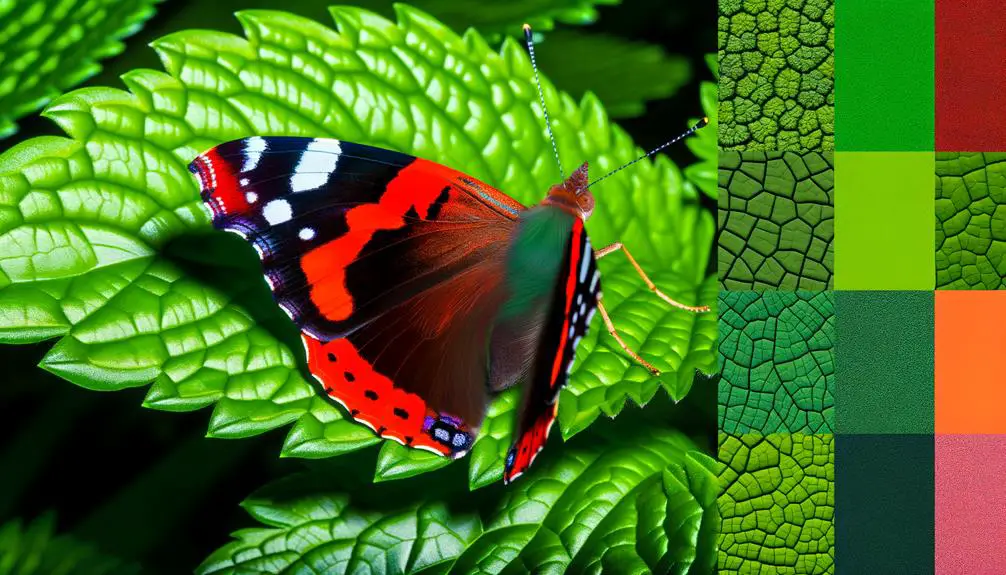
Many butterfly species exhibit toxicity as a defense mechanism, often deriving their noxious qualities from the plants they consume during their larval stage. This biochemical strategy deters predators and enhances survival rates.
For example, monarch butterflies sequester cardenolides from milkweed, rendering them unpalatable. Similarly, pipevine swallowtails accumulate aristolochic acids from pipevines, conferring toxicity that can cause emesis in predators. Evidence shows that these butterflies exhibit aposematic coloration, a visual warning to potential threats.
- Awe-inspiring adaptability: Butterflies transform plant toxins into protective armor.
- Nature’s intricate design: Larval diet directly influences adult butterfly survival.
- Defensive elegance: Bright colors signal danger to predators.
- Symbiosis in ecosystems: Plants and butterflies evolve together for mutual benefit.
This defensive toxicity is essential for their ecological niche, ensuring evolutionary success.
Human Interaction and Safety
Despite their vivid coloration and potential toxicity to predators, Red Admiral butterflies pose no significant threat to humans.
Scientific observations indicate that the toxins present in these butterflies are primarily aimed at deterring avian and other insectivorous predators.
Human interaction with Red Admirals, such as handling or accidental contact, generally results in no adverse effects.
Entomological studies have demonstrated that the chemical compounds within their bodies lack the potency to elicit harmful reactions in human skin or mucous membranes.
Additionally, there is no evidence to suggest that these butterflies possess any venomous capabilities.
Consequently, from a safety standpoint, Red Admiral butterflies can be considered harmless to humans, making them a benign subject for butterfly enthusiasts and naturalists alike.
Myths and Misconceptions
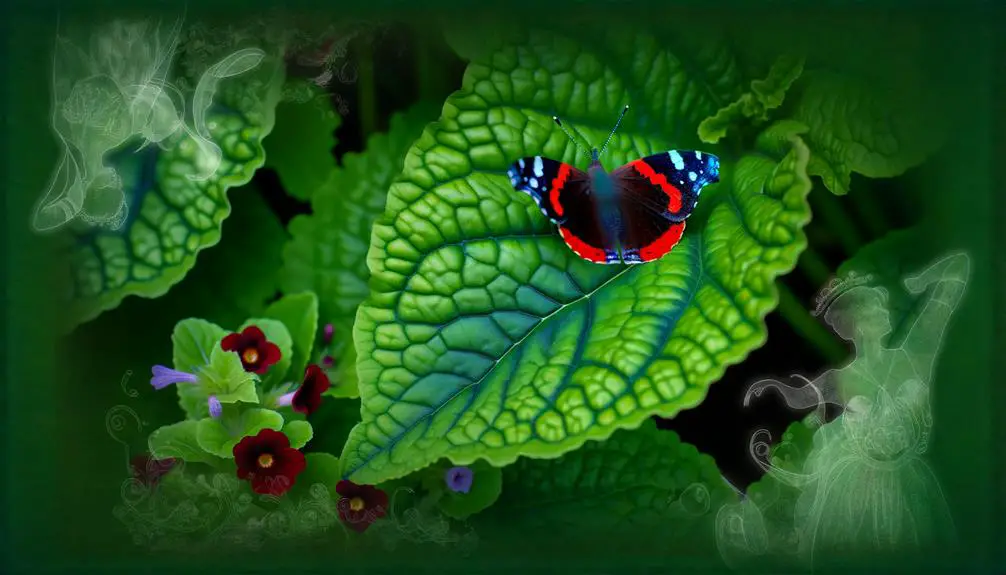
The misconception that Red Admiral butterflies are poisonous likely stems from a broader misunderstanding of butterfly defense mechanisms, such as aposematism and mimicry.
Despite their vivid coloration, there is no empirical evidence indicating that Red Admirals possess toxic properties harmful to humans or predators.
This myth persists due to generalizations made about butterfly species with similar appearance and defensive strategies.
Common Poisonous Butterfly Myths
Numerous misconceptions persist regarding the toxicity of butterflies, often stemming from a lack of scientific understanding and anecdotal evidence. These myths can lead to undue fear and misinformation about these generally harmless insects.
A thorough review of entomological studies reveals that while some butterflies possess chemical defenses, the majority, including the Red Admiral, are non-toxic to humans.
Consider the following common myths:
- All brightly colored butterflies are poisonous.
- Butterflies can inject venom through their proboscis.
- Handling butterflies can cause skin irritation or allergic reactions.
- Butterflies are dangerous to pets and small children.
Dispelling these myths requires a commitment to factual education and scientific literacy, ensuring that butterflies are appreciated for their ecological roles rather than feared.
Misunderstood Butterfly Defense Mechanisms
Butterfly defense mechanisms, often misunderstood, involve complex biochemical strategies and behavioral adaptations that are frequently misinterpreted as harmful to humans.
For instance, the Red Admiral (Vanessa atalanta) employs aposematic coloration to deter predators, which is mistakenly perceived as a sign of toxicity. However, this species lacks the toxic compounds found in genuinely poisonous butterflies like the Monarch (Danaus plexippus).
Additionally, the Red Admiral’s erratic flight patterns serve as evasive maneuvers rather than aggressive behavior.
Scientific studies confirm that, contrary to popular belief, these butterflies pose no threat to human health.
Understanding these defense mechanisms within an ecological and evolutionary context dispels myths and highlights the sophisticated survival strategies of butterflies without attributing unnecessary danger to them.
Importance in Ecosystems
Integral to various ecological networks, Red Admiral butterflies (Vanessa atalanta) contribute considerably to pollination and serve as an essential food source for predators.
Their role in pollination supports floral biodiversity, aiding in the reproductive success of numerous plant species. Additionally, Red Admirals serve as prey for birds, spiders, and other insectivores, thus sustaining higher trophic levels.
- Vital pollinators ensuring the survival of diverse plant species.
- Crucial prey for maintaining the stability of predator populations.
- Indicators of environmental health and biodiversity.
- Participants in nutrient cycling through their larval and adult stages.
This butterfly species, consequently, plays a multifaceted role in maintaining ecosystem equilibrium and promoting biological diversity.
Do Red Admiral Butterfly Like Tomatoes
Red Admiral butterflies (Vanessa atalanta) are indeed attracted to tomatoes, particularly when they are overripe or rotting. These butterflies are drawn to the sugars and fermentation products found in decaying fruits, which provide them with essential nutrients.
In addition to tomatoes, they also enjoy other fruits like apples and pears that have fallen and begun to ferment.
Conclusion
To sum up, the Red Admiral butterfly, while enchanting with its striking appearance, is not poisonous.
Its survival relies on various defense mechanisms, including rapid flight and mimicry, rather than toxicity.
Understanding the complex interplay between this butterfly’s diet, habitat, and predators reveals a delicate balance within ecosystems.
As essential pollinators, Red Admirals contribute considerably to ecological health, underscoring the importance of their conservation.
Like a well-tuned symphony, each element harmonizes to sustain biodiversity.


